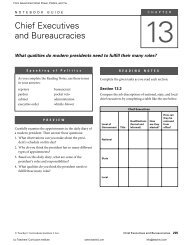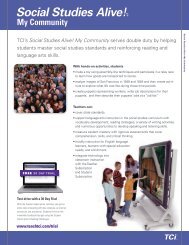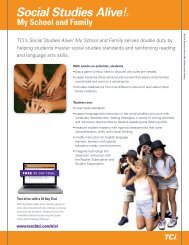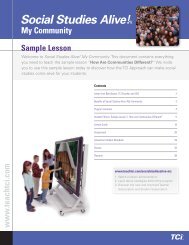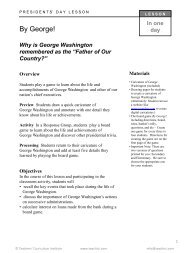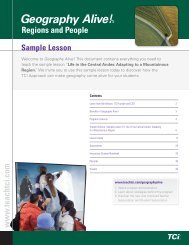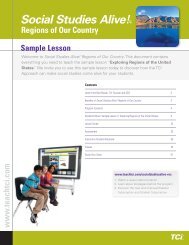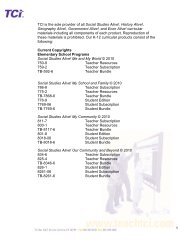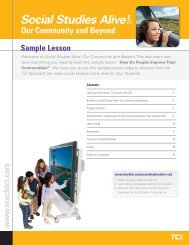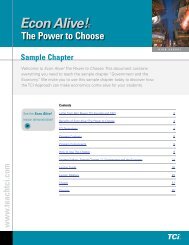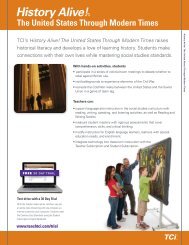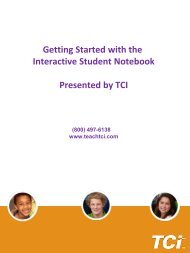Social Studies Alive! Me and My World | Sample Chapter ... - TCI
Social Studies Alive! Me and My World | Sample Chapter ... - TCI
Social Studies Alive! Me and My World | Sample Chapter ... - TCI
- No tags were found...
You also want an ePaper? Increase the reach of your titles
YUMPU automatically turns print PDFs into web optimized ePapers that Google loves.
enefitsBenefits of <strong>Social</strong> <strong>Studies</strong> <strong>Alive</strong>!<strong>Me</strong> <strong>and</strong> <strong>My</strong> <strong>World</strong>How can we help our students tounderst<strong>and</strong> their world? How do weprepare them to participate in it effectively?To these core social studies goals, <strong>TCI</strong> addsanother: How do we get students excitedabout this learning? <strong>Social</strong> <strong>Studies</strong> <strong>Alive</strong>!<strong>Me</strong> <strong>and</strong> <strong>My</strong> <strong>World</strong> delivers on all threegoals. Interactive classroom experiences,coupled with fascinating reading, engageall learners in today’s diverse classroom.<strong>TCI</strong> recognizes the challenge to teachers offitting social studies into a school day thatmust concentrate so heavily on the threeR’s. To meet this challenge, <strong>TCI</strong> has createda social studies program that serves doubleduty: reinforcing reading <strong>and</strong> language artsskills at the same time that students learnsocial studies.<strong>Social</strong> <strong>Studies</strong> <strong>Alive</strong>! <strong>Me</strong> <strong>and</strong> <strong>My</strong> <strong>World</strong> wascreated by teachers, for teachers. The programis flexible <strong>and</strong> easy to use, providinga variety of ways to meet student needs.Teachers can• Cover state st<strong>and</strong>ards.• motivate student reading with the ReadingFurther feature in each lesson—a highinterestcase study that drills down intointeresting events, concepts, <strong>and</strong> peoplediscussed in the lesson.• support language arts instruction in thesocial studies curriculum with vocabularydevelopment, reading strategies, a varietyof writing activities, <strong>and</strong> numerousopportunities to develop speaking <strong>and</strong>listening skills.• <strong>Me</strong>asure student mastery withobservational checklists that cover socialstudies, language arts, <strong>and</strong> participationobjectives.• modify instruction for students needingadditional support <strong>and</strong> for enrichment.• extend learning with recommendedadditional reading opportunities <strong>and</strong> <strong>TCI</strong>’sonline Enrichment Resources, includinga Biography Bank <strong>and</strong> EnrichmentReadings.<strong>Social</strong> <strong>Studies</strong> <strong>Alive</strong>! <strong>Me</strong> <strong>and</strong> <strong>My</strong> <strong>World</strong> willhelp you ignite your students’ passion forlearning social studies <strong>and</strong> your passion forteaching it!<strong>Social</strong> <strong>Studies</strong> <strong>Alive</strong>! <strong>Me</strong> <strong>and</strong> <strong>My</strong> <strong>World</strong>3
How Do I4Make Friends?| Big Book | Lesson Guide | Assessment | Poster Placards |6I introduce myself.
| Big Book | Lesson Guide | Assessment | Poster Placards |7I ask a friend to play.20
| Big Book | Lesson Guide | Assessment | Poster Placards |8I share.
22| Big Book | Lesson Guide | Assessment | Poster Placards |9I am kind.
| Big Book | Lesson Guide | Assessment | Poster Placards |11They shared.They gave thanks.
S o c i a l S t u d i e s S k i l l B u i l d e rHow Do I Make Friends?OverviewStudents learn how to interact respectfully with one another in the classroom.In a Preview activity, students offer their ideas for making friends with a newcomer<strong>and</strong> define friend. In a series of <strong>Social</strong> <strong>Studies</strong> Skill Builders, studentslearn four skills for making new friends. In Reading Further, they learn howmaking new friends was important to the Pilgrims. Finally, in a Processingactivity, students use what they have learned to role-play effective social interactionswith one another.Objectives<strong>Social</strong> <strong>Studies</strong>• Describe what it means to be a friend.• Distinguish between friendly (kind) <strong>and</strong> unfriendly (selfish) behavior.• Identify the role that friendship played in the Pilgrims’ encounters with theWampanoags.Language Arts• Perform modeled social interactions. (speaking <strong>and</strong> listening)• Complete simple sentences. (writing)<strong>Social</strong> <strong>Studies</strong> Vocabularyfriend, introduce, shareC H A P T E R4Materials<strong>Social</strong> <strong>Studies</strong> <strong>Alive</strong>! <strong>Me</strong><strong>and</strong> <strong>My</strong> <strong>World</strong> Big BookTransparencies 4A–4FPoster Placards 4A–4GLesson Masters• Information Masters4A <strong>and</strong> 4B• Student H<strong>and</strong>out 4• Interactive StudentH<strong>and</strong>outs 4A <strong>and</strong> 4BCD Track 3dowel or large craft stickpocket chartconstruction paperblockspicture booksmural paperTime EstimatesPreview: 20 min.<strong>Social</strong> <strong>Studies</strong> SkillBuilder: 4 sessions(20 min. or 25 min.)Reading Further: 25 min.Processing: 20 min.| Big Book | Lesson Guide | Assessment | Poster Placards |12Note: <strong>TCI</strong> uses the terms “visual” <strong>and</strong> “transparency” interchangeably.
P l a n n i n g G u i d eActivity Suggested Time MaterialsPreview• Connecting to PriorKnowledge• Building BackgroundKnowledge• Developing Vocabulary<strong>Social</strong> <strong>Studies</strong> Skill BuilderLearning to interact socially inorder to make new friends20 minutes • <strong>Social</strong> <strong>Studies</strong> <strong>Alive</strong>! <strong>Me</strong> <strong>and</strong> <strong>My</strong> <strong>World</strong>Big Book, <strong>Chapter</strong> 4• Poster Placard 4A• Information Master 4A (enlarge <strong>and</strong>cut apart)• CD Track 3• pocket chart• dowel or large craft stick20-minute sessions (2)• Introductions (Steps 1<strong>and</strong> 2)• Invitations to play (Step 3)25-minute sessions (2)• Sharing (Step 4)• Kind words <strong>and</strong> actions(Step 5)• <strong>Social</strong> <strong>Studies</strong> <strong>Alive</strong>! <strong>Me</strong> <strong>and</strong> <strong>My</strong> <strong>World</strong>Big Book, <strong>Chapter</strong> 4• Transparencies 4A–4F or PosterPlacards 4B–4G• Student H<strong>and</strong>out 4 (2–4 sets, copiedonto heavy paper <strong>and</strong> cut apart)• Interactive Student H<strong>and</strong>out 4A (1 copyper student)• CD Track 3• Buddy Butterfly puppet (from Preview)• construction paper (white <strong>and</strong> colored)| Big Book | Lesson Guide | Assessment | Poster Placards |13Reading FurtherLearning about the Pilgrims<strong>and</strong> the native people whobefriended them long ago25 minutes • <strong>Social</strong> <strong>Studies</strong> <strong>Alive</strong>! <strong>Me</strong> <strong>and</strong> <strong>My</strong> <strong>World</strong>Big Book, <strong>Chapter</strong> 4 Reading Further• Information Master 4B• Interactive Student H<strong>and</strong>out 4B (1 copyper student)ProcessingDemonstrating how to make afriend20 minutes • <strong>Social</strong> <strong>Studies</strong> <strong>Alive</strong>! <strong>Me</strong> <strong>and</strong> <strong>My</strong> <strong>World</strong>Big Book, <strong>Chapter</strong> 4• CD Track 3• blocks• picture books• mural paper34 <strong>Chapter</strong> 11 4
© Teachers’ Curriculum Institute How Do I Make Friends? 29Preview1 Connecting to Prior Knowledge: Help students define what a friend is.• Before beginning the Preview, create a puppet from Poster Placard 4A:Buddy Butterfly. Attach the puppet to a dowel or large craft stick. Alsomake an enlargement of Information Master 4A: I Can Make New Friends<strong>and</strong> cut the lyrics into sentence strips. (Option: Alternatively, h<strong>and</strong>writethe lyrics on sentence strips.)FOLDP r o c e d u r e sBuddy Butterfl yP oP so ts et r e r P lP al ca ac ra d r d 4 A1© Teachers’ Curriculum Institute <strong>Social</strong> <strong>Studies</strong> <strong>Alive</strong>! <strong>Me</strong> <strong>and</strong> <strong>My</strong> <strong>World</strong> 6Poster Placard 4A| Big Book | Lesson Guide | Assessment | Poster Placards |I n f o r m a t i o n M a s t e r 41 AI Can Make New FriendsHow do I make new friends?How do I make new friends?I introduce myself to someone I don’t know.How do I make new friends?How do I make new friends?I ask a friend to play with me.How do I make new friends?How do I make new friends?I always share <strong>and</strong> I am always kind.How do I make new friends?How do I make new friends?I can make new friends.Would you like to be my friend?14How Do I Make Friends? 29• To introduce Buddy Butterfly, tell students that someone new has come tovisit your class. Explain that he wants to make some new friends, but heis shy <strong>and</strong> isn’t sure if he wants to come out. You may want to have BuddyButterfly peek out from behind something. Ask: What can we do to helpBuddy Butterfly come out? As needed, model a few ideas, such as “talkto him” <strong>and</strong> “play with him.” Record students’ ideas, <strong>and</strong> then read theirideas back to them. Encourage students to try some of their ideas to convinceBuddy Butterfly to come out.• Let students know that their ideas have convinced Buddy Butterfly tocome out to meet them. Introduce Buddy Butterfly to the class. HaveBuddy say his name <strong>and</strong> ask the students if they would like to be friends.• Ask students to define what a friend is. Record their answers. Then paraphraseby saying, A friend is someone you like to be with <strong>and</strong> someone wholikes to be with you. Have Buddy Butterfly whisper in your ear, <strong>and</strong> thensay that Buddy Butterfly is very happy to have met so many new friends.2 Building Background Knowledge: Help students recognize what it means tobe a friend <strong>and</strong> how to make a new one.• Open the <strong>Social</strong> <strong>Studies</strong> <strong>Alive</strong>! <strong>Me</strong> <strong>and</strong> <strong>My</strong> <strong>World</strong> Big Book to <strong>Chapter</strong> 4.• Read aloud the four pages of <strong>Chapter</strong> 4, having students repeat thetitle <strong>and</strong> the sentences as you point to each word. Point out similaritiesbetween the text <strong>and</strong> students’ ideas about how to make a new friend, <strong>and</strong>praise the class for their insights.Information Master 4AHow Do I Make Friends? 35
© Teachers’ Curriculum InstituteP r o c e d u r e s• Help students learn a song about making friends. Play CD Track 3, “I CanMake New Friends.” Display the sentence-strip lyrics in the pocket chart.Teach the words line by line. Then sing the song all together.3 Developing Vocabulary: Introduce the key social studies terms—friend,introduce, <strong>and</strong> share—using methods described in Solutions for EffectiveInstruction.<strong>Social</strong> <strong>Studies</strong> Skill Builder1 Help students practice the social skill of introducing themselves.• Reread the title question <strong>and</strong> the first page of <strong>Chapter</strong> 4 in the Big Book.Encourage students to interact with the text <strong>and</strong> picture by asking suchquestions as: What do you think these children are doing? (meeting eachother, talking, listening) What might they be saying to each other? (hello,their names)• Display Poster Placard 4B or Transparency 4A: I Can Introduce <strong>My</strong>self.Read the steps aloud while using Buddy Butterfly to model each step witha volunteer. Ask students to take turns introducing themselves to BuddyButterfly. (Option: Have students select a puppet or other toy to introduceto Buddy Butterfly <strong>and</strong> to one another.)2 Have students play the Circle Introduction game.• Divide the class in half. Have students form two circles, one inside theother. Direct the inside circle to face the outside circle. Ask students tofind a partner who is facing them. Make sure everyone has a partner.• Explain that in this game, students will practice introducing themselves.Although they may already know one another, they should pretend thatthis is the first time they have met. Start by having students in the outsidecircle introduce themselves to students in the inside circle, following thefive steps on Poster Placard 4B or Transparency 4A.• After the first round of introductions, explain how the game proceeds. Asyou play CD Track 3 again, have students in the outside circle join h<strong>and</strong>s<strong>and</strong> move to the left while the inside circle st<strong>and</strong>s still. When you stop themusic, have students stop immediately <strong>and</strong> drop h<strong>and</strong>s. Tell them to taketurns introducing themselves to the person st<strong>and</strong>ing across from them.(Note: Ask those who do not have a partner when the music stops to raisetheir h<strong>and</strong>s, <strong>and</strong> help them find a partner.)• Continue to play the Circle Introduction game, starting <strong>and</strong> stopping themusic several times. Afterward, tell students they have learned one greatway to make a new friend.• Review the first page of <strong>Chapter</strong> 4 in the Big Book. Ask: How would youintroduce yourself to the children in the picture? Have several students demonstrateintroducing themselves.Reading Strategy:Do Shared ReadingRead the lyrics togetheragain after students haveheard the song more thanonce. This provides a modelof fluent, phrased reading.Highlight the high-frequencywords do, new, <strong>and</strong> friendin the lyrics for repeatedreading practice.T r a n s p a r e n c y 41 AI Can Introduce <strong>My</strong>self1. Approachthe person.2. Look the personin the eye.3. Smile.4. Say,5. Be polite.Say,“It’s nice tomeet you, _____.”“Hello, my nameis ________.What’s yours?”<strong>Social</strong> <strong>Studies</strong> <strong>Alive</strong>! <strong>Me</strong> <strong>and</strong> <strong>My</strong> <strong>World</strong> 6Transparency 4APoster Placard 4B| Big Book | Lesson Guide | Assessment | Poster Placards |1536 <strong>Chapter</strong> 4
© Teachers’ Curriculum Institute© Teachers’ Curriculum Institute© Teachers’ Curriculum Institute3 Help students practice inviting a friend to play.• Before class, copy Student H<strong>and</strong>out 4: Cards for Asking a Friend to Playonto heavy paper <strong>and</strong> cut out the cards. Prepare an appropriate number ofsets for the class; each card should have at least one match. (Option: Youmay want to color <strong>and</strong> laminate the cards.)• To introduce the idea of inviting someone to play, restate the questionin the <strong>Chapter</strong> 4 title, <strong>and</strong> then read page 10 in the Big Book. Encouragestudents to interact with the text <strong>and</strong> picture by asking such questions as:What is happening in this picture? How can you tell that the children aregetting along? What types of things do you like to do with your friends?• Display Poster Placard 4C or Transparency 4B: I Can Ask a Friend to Play.Read the steps aloud while using Buddy Butterfly to model each step witha volunteer. Have students take turns inviting Buddy Butterfly to play.• Demonstrate the Asking a Friend to Play game. Show students one of thecards from Student H<strong>and</strong>out 4 <strong>and</strong> have them identify the activity pictured.Keep this card for Buddy Butterfly. Give three other cards to threevolunteers. Have Buddy Butterfly approach the first volunteer with hiscard <strong>and</strong> model the steps from Poster Placard 4C or Transparency 4B. Thestudent should respond yes or no, depending on the activity illustrated onhis or her card. Finish modeling with the other two students. (Note: Tolayer skills, ask students to introduce themselves before inviting their partnerto play.)• To play the game, distribute one card to each student. Ask students towalk around the room inviting friends to play, until they find someonewith a matching card. When they have found a new friend, they should sitdown together.• For further practice with invitations, play a second version of the Askinga Friend to Play game. This version is similar to the Circle Introductiongame in Step 2, but in this version, each student has one card from StudentH<strong>and</strong>out 4. Students in the outside circle again rotate to the music (CDTrack 3). When the music stops, students follow the five steps to ask theirpartner to play. If the two cards match, the player kindly accepts the invitation.If the cards do not match, the player politely declines. Start <strong>and</strong>stop the music several times. Afterward, tell students they have learnedanother great way to make a friend.4 Help students distinguish between friendly (kind) <strong>and</strong> unfriendly (selfish)behavior.• To reintroduce the idea of sharing as friendly behavior, restate thequestion in the <strong>Chapter</strong> 4 title <strong>and</strong> then read page 11 of the Big Book.Encourage students to interact with the text <strong>and</strong> picture by asking suchquestions as: What are these children doing? What clues in the picture tellyou they are happily sharing?P r o c e d u r e sS t u d e n t H a n d o u t 41 AdrawingS t u d e n t H a n d o u t 14A30 <strong>Chapter</strong> 4books32 <strong>Chapter</strong> 4jump ropeballS tS ut du ed ne t n t H Ha na dn od uo t u t 1 A4Cards for Asking a Friend to Playblockspainting© Teachers’ Curriculum Institute How Do I Make Friends? 31Student H<strong>and</strong>out 4T r a n s p a r e n c y 14 ABI Can Ask a Friend to Play1. Approachthe person.2. Look the personin the eye.3. Smile.4. Ask,5. Answerpolitely,“Yes, thanks forasking.” Or, “No,thank you. I’mgoing to paint.”“Hi, would youlike to playblocks?”Transparency 4BPoster Placard 4C<strong>Social</strong> <strong>Studies</strong> <strong>Alive</strong>! <strong>Me</strong> <strong>and</strong> <strong>My</strong> <strong>World</strong> 7Writing Tip: Do SharedWritingWork as a class to write ashort story about how two ofthe students became friends.Did they introduce themselves?Did they invite eachother to join in their play?Recast students’ ideas assimple sentences. Write theseon the board or chart paper,pointing out the capital letterthat starts each sentence <strong>and</strong>the punctuation that ends it.| Big Book | Lesson Guide | Assessment | Poster Placards |16How Do I Make Friends? 37
© Teachers’ Curriculum Institute© Teachers’ Curriculum Institute© Teachers’ Curriculum Institute© Teachers’ Curriculum InstituteP r o c e d u r e s• Show Poster Placards 4D–4G or Transparencies 4C–4F: Are We Sharing?one at a time to discuss the four scenarios, with children sharing or notsharing flowers, a ball, a puzzle, <strong>and</strong> colored markers. For each scene, ask:What do you see? What is happening? Are the children being friendly? Whyor why not? Is anyone being selfish?• For each scene that shows children who are not sharing, ask students whatthe pictured children could say respectfully to request that their friendshare. Have several volunteers demonstrate what they might say. If youare using the transparencies, choose students to “step into” the image,modeling the behavior <strong>and</strong> an appropriate interaction. As a prompt, youmight model asking a polite question such as, May I please play ball withyou? (Option: Share a less respectful or more dem<strong>and</strong>ing way of asking,typical of what is sometimes heard on the playground, <strong>and</strong> ask students toimprove upon your request.)• Place students in pairs with a sheet of construction paper <strong>and</strong> crayons.Display the two unfriendly (nonsharing) scenarios again (Poster Placards4E <strong>and</strong> 4G, or Transparencies 4D <strong>and</strong> 4F). Explain that students will workin pairs to create a new picture that shows the same children sharing. Askpartners to decide which picture they would like to improve. Point outthat to complete this picture they will have to practice sharing both drawingtools <strong>and</strong> their ideas. Allow time for them to draw <strong>and</strong> to invent dialoguebetween the pictured children that leads to sharing.• <strong>Me</strong>et together as a group to talk about students’ shared drawings. Askeach pair to explain their illustration <strong>and</strong> the dialogue they made up.5 Help students identify words <strong>and</strong> actions that signify friendly behavior<strong>and</strong> respect for others.• Prepare a bulletin board for a Kindness Garden. Decorate it with greenconstruction paper to represent grass <strong>and</strong> flower stems.• To introduce the concepts of kind words <strong>and</strong> kind actions, restate thequestion in the <strong>Chapter</strong> 4 title, <strong>and</strong> then read page 12 of the Big Book.Encourage students to interact with the text <strong>and</strong> pictures by asking suchquestions as: What seems to be happening in the pictures? What are somekind words that these children might be saying?• Direct attention to the Kindness Garden. Explain that this garden is oneof Buddy Butterfly’s favorite places to make new friends. Tell students thatthey are going to make “flowers of kindness” for the garden.• Distribute a copy of Interactive Student H<strong>and</strong>out 4A: A Flower of Kindnessto each student. Read the words in the circle aloud, <strong>and</strong> then have studentsrepeat them. Explain that they should finish this sentence by writingsomething kind that they say to or do with a friend. Students who needhelp may dictate their words.Are We Sharing?Are We Sharing?Are We Sharing?T r a n s p a r e n c y 14 AC<strong>Social</strong> <strong>Studies</strong> <strong>Alive</strong>! <strong>Me</strong> <strong>and</strong> <strong>My</strong> <strong>World</strong> 8Transparencies 4C–4FPoster Placards 4D–4GIS nt ut ed re an ct t iH vae n Sd to u dt e 1n At H a n d o u t 4 A34 <strong>Chapter</strong> 4A Flower of KindnessI am a good friendwhen I.T r a n s p a r e n c y 14 AET r a n s p a r e n c y 14 DA<strong>Social</strong> <strong>Studies</strong> <strong>Alive</strong>! <strong>Me</strong> <strong>and</strong> <strong>My</strong> <strong>World</strong> 10<strong>Social</strong> <strong>Studies</strong> <strong>Alive</strong>! <strong>Me</strong> <strong>and</strong> <strong>My</strong> <strong>World</strong> 9Interactive Student H<strong>and</strong>out 4A| Big Book | Lesson Guide | Assessment | Poster Placards |1738 <strong>Chapter</strong> 4
• Brainstorm kind words <strong>and</strong> kind actions, listing students’ ideas on theboard. If necessary, suggest typical classroom situations to prompt kindresponses, including the expressions “good morning,” “please,” “thankyou,” <strong>and</strong> “you’re welcome,” <strong>and</strong> the actions of helping, taking turns, sharing,<strong>and</strong> listening quietly. For example: What kind words do you say whenyou greet your teacher in the morning? What kind action do you do when aclassmate has spilled his box of crayons on the floor? Have students finishthe sentence in the center of the flower, using the listed ideas as models.• Use a copy of the h<strong>and</strong>out to demonstrate how to finish the flower. Createpetals by tearing colored construction paper. Glue the petals around theperimeter of the circle, leaving the flower’s center uncovered.• Distribute construction paper <strong>and</strong> glue sticks. As the students work ontheir flowers, have Buddy Butterfly fly around the classroom listening forkind words <strong>and</strong> watching for kind actions.• After adding the flowers to your display, spend time exploring theKindness Garden with the class. Lead students in reading aloud the sentenceon each flower. Ask volunteers to suggest situations in which eachkind word or action would be useful. Alternatively, have Buddy Butterflysuggest a situation <strong>and</strong> help students find an appropriate response amongthe flowers.P r o c e d u r e s| Big Book | Lesson Guide | Assessment | Poster Placards |18Reading Further: How Did They Make Friends Long Ago?1 Help students identify the role that friendship played in the Pilgrims’encounters with the Wampanoags.• Gather students on the rug to hear a read-aloud story. Open the Big Bookto Reading Further 4 <strong>and</strong> read aloud the title. Give students a chance toexamine the pictures on pages 13 <strong>and</strong> 14. Ask about each one: What doyou see in this picture? Who do you think these people might be? What doyou think is happening? Do you think this is a picture from today or fromlong ago? Tell students you will read them a story, <strong>and</strong> they should listen tosee if their ideas are right.• Read aloud the story from Information Master 4B: Making Friends LongAgo. Afterwards, ask students to point out anything in the paintings thatthey heard about in the story. Help them identify both Squanto <strong>and</strong> thePilgrims.• Prompt students to discuss the idea that part of being a friend is to share<strong>and</strong> be kind, by asking such questions as: How was Squanto a good friend?What did he share with the Pilgrims? In what way was he kind to them?Direct attention to the bottom picture on page 14 <strong>and</strong> ask: How did thePilgrims <strong>and</strong> the Wampanoags behave as friends during the harvest festival?I n f So tr um da et ni t o n H aM na ds ot ue r t 14 ABMaking Friends Long AgoDo you know the story of the first Thanksgiving? Did you know that it is a storyof friendship? This is an old, old story.It all began almost 400 years ago when people we now call the Pilgrims cameto America. They sailed from Engl<strong>and</strong> on a ship. They wanted to find a new home.[Point out on the globe where the Pilgrims came across the sea from Engl<strong>and</strong> to America,<strong>and</strong> point out where they l<strong>and</strong>ed in what is now Massachusetts.]When the Pilgrims arrived, it was wintertime. The weather was cold <strong>and</strong> snowy.The Pilgrims had left their homes <strong>and</strong> friends <strong>and</strong> families back in Engl<strong>and</strong>. Theyhad to begin all over again in this new place. It was not easy. There were no cities<strong>and</strong> shops, like the ones they left in Engl<strong>and</strong>. They had to build houses. And theyhad to clear l<strong>and</strong> where they could grow food. Life was very hard. Many of themdied during the first winter.How did these people find a way to live? New friends helped them. One newfriend was called Squanto. He was an American Indian, of the Wampanoag [pronouncedwahmp-uh-NO-ag, or sometimes wahmp-uh-NAHG] tribe. His people hadlived in America for thous<strong>and</strong>s of years before the Pilgrims came. Many of theWampanoags did not trust these people who had moved into their homel<strong>and</strong>s. Butit was their way to be polite <strong>and</strong> kind to strangers. Squanto became a friend to thePilgrims.When spring came, Squanto helped the newcomers. He showed them how toplant corn <strong>and</strong> how to get syrup from trees. Squanto also introduced the Pilgrims totheir Wampanoag neighbors.Even with Squanto’s help, that summer was very hard for the Pilgrims. They hadmuch to learn. They had to learn where to fish. They had to learn how to hunt wildbirds, like ducks <strong>and</strong> geese. They had to learn which plants were safe to eat.When fall came, the Pilgrims were thankful to still be alive. Fall was harvesttime, <strong>and</strong> the Pilgrims had a special feast to celebrate. Many of the Wampanoagpeople came. They brought deer meat to share with the Pilgrims. The celebrationwent on for three days. Everyone ate food. Everyone shared. The Pilgrims gavethanks for all that they had.Many years later, people started to call this harvest feast “the first Thanksgiving.”How was it like the Thanksgiving we celebrate today? How was it different?© Teachers’ Curriculum Institute How Do I Make Friends? 35Information Master 4BHow Do I Make Friends? 39
© Teachers’ Curriculum InstituteP r o c e d u r e s• As you help students explore the details in these pictures, explain thatthese drawings are very old—but they are not as old as the story itself.No one knows exactly what this “first Thanksgiving” looked like. Therewere no cameras, <strong>and</strong> no one has found any drawings made at the time.These paintings, which were done many years later, are just someone’s ideaof what life was like for the Pilgrims. Sometimes when we study thingsthat happened long ago, we have actual pictures that give us good clues.Other times, we have to guess. Students should underst<strong>and</strong> that each ofthese pictures is some painter’s guess about what things looked like whenSquanto <strong>and</strong> the other Wampanoags became friends to the Pilgrims.• Spend a bit of time discussing the last questions in the read-aloud, askingstudents what is the same <strong>and</strong> different about Thanksgiving as we celebrateit today. Remind students about family traditions, <strong>and</strong> briefly discussany Thanksgiving traditions they know.2 Help students re-create the basic story sequence of the Pilgrims’ arrival inAmerica as it unfolded through a year.• Write four events on sentence strips. Display the strips r<strong>and</strong>omly. Helpstudents read each strip <strong>and</strong> then place the four sentences in sequence in apocket chart. For example, use sentences like these:In winter, the Pilgrims came to America.The next spring, Squanto helped the Pilgrims plant corn.All summer, the Pilgrims worked hard.That fall, the Pilgrims <strong>and</strong> Wampanoags shared a special meal.While students are placing the strips in order, encourage them to talkabout the sequence of events using terms such as before <strong>and</strong> after, or first,next, <strong>and</strong> last.• After students have successfully reconstructed the story sequence, askthem to retell the story, adding details they remember from the read-aloudor from the pictures in the Big Book. Have them identify events from thebeginning, middle, <strong>and</strong> end of the story.3 Help students connect this story to making new friends in their own lives.• Call on small groups of students to role-play historical figures in theread-aloud story. Have them use their social skills for making newfriends to dramatize what it might have been like when the Pilgrims <strong>and</strong>Wampanoags met. Ask the Pilgrims: How would you introduce yourselves?How would you ask for help? Ask the Wampanoags: How would you introduceyourselves? What would you tell the Pilgrims to help them?• Distribute a copy of Interactive Student H<strong>and</strong>out 4B: Friends Can Help Us toeach student. Read the title <strong>and</strong> the unfinished sentence aloud. Explain thatstudents should draw a picture showing how a new friend helps them <strong>and</strong>finish the sentence to tell about their picture. (Note: If students have troublethinking of an actual new friend who helps them, encourage them to think of anew friend they would like to make. Ask: How could this new friend help you?)IS nt ut ed re an ct t iH vae n Sd to u dt e 1n At H a n d o u t 4 BFriends Can Help Us<strong>My</strong> new friend helps me.36 <strong>Chapter</strong> 4Interactive Student H<strong>and</strong>out 4B| Big Book | Lesson Guide | Assessment | Poster Placards |1940 <strong>Chapter</strong> 4
Processing1 Prepare materials for the activity. Use mural paper to make a banner forstudents to decorate during the activity. Print the words, “We Are Friends!”<strong>and</strong> leave lots of drawing room on the banner. Prepare three stations: blocks,books, <strong>and</strong> drawing (the banner). Copy the corresponding cards fromStudent H<strong>and</strong>out 4, making enough so that each student gets one card. Thereshould be an equal number of partners at each station. (Note: If you have anodd number of students, have one set of three work together.)2 Review the four elements of making new friends. Read <strong>Chapter</strong> 4 of the BigBook again <strong>and</strong> have students repeat the sentence on each page. Then playCD Track 3 while students sing along.3 Have students role-play making friends to play with.• Tell students they will visit three Friendship Stations to show how muchthey have learned about making friends. Explain that they will play witha different friend at each station. Briefly explain the goal of each station:exploring books with a friend, building blocks with a friend, <strong>and</strong> makingdrawings to decorate the class friendship banner.• Give each student one of the cards (blocks, books, or drawing) fromStudent H<strong>and</strong>out 4. Have students find someone with a matching card,introduce themselves, ask each other to play, <strong>and</strong> go to the station that ispictured on their cards. You might use Buddy Butterfly to model the steps.(Note: When the students are at their stations, collect the cards.)• After five minutes, tell students which station they will visit next. Beforerotating, ask them to introduce themselves to another student within theirgroup <strong>and</strong> proceed to the next station together. Repeat this step so studentsvisit all three stations.• During the rotations, use Buddy Butterfly to compliment well-done introductions,comment on how well students are sharing, <strong>and</strong> praise studentsfor using kind words <strong>and</strong> kind actions. (Note: Save the Buddy Butterflypuppet for use in subsequent chapters.)4 Hang the “We Are Friends!” banner. Explain that the banner will helpstudents remember what a terrific job they did making friends. Share someof the friendly observations Buddy Butterfly made during the activity. Ask:What friendly things did you notice at your stations? Where else can you usethe skills you’ve learned to make new friends? (on the playground, in afterschoolcare, at the park, on sport teams, <strong>and</strong> so on)P r o c e d u r e s| Big Book | Lesson Guide | Assessment | Poster Placards |20AssessmentFor assessment of student success during the activity, refer to the observationalchecklist for this chapter in the Lesson Masters. You may use the checklist toassess individual students or the class as a whole.How Do I Make Friends? 41
D i f f e r e n t i a t i n g I n s t r u c t i o nStudents Needing Additional SupportAs students work on their Interactive Student H<strong>and</strong>outs, assist them with theirwriting as needed. On Interactive Student H<strong>and</strong>out 4B: Friends Can Help Us,encourage them to draw a picture first to capture their idea <strong>and</strong> guide theirwriting. If students are challenged by writing, have them dictate the words toyou. Depending on the students’ individual needs, either write all the words forthem, allow them to copy your words onto their page, or write the words lightly<strong>and</strong> have the students trace over the letters.EnrichmentProvide picture books about friendship from the class or school library (see, forexample, the Additional Reading Opportunities on the following page). Havestudents read or examine one book <strong>and</strong> draw a scene that shows two charactersbecoming friends or being kind to one another. Then ask students to writeabout (or share with the class orally) specific friendly behaviors demonstratedby the chosen characters, drawing on ideas the class discussed during the<strong>Chapter</strong> 4 activities.| Big Book | Lesson Guide | Assessment | Poster Placards |21In conjunction with the read-aloud about the Pilgrims <strong>and</strong> Wampanoags(<strong>and</strong> perhaps the Plimoth Plantation books listed under Additional ReadingOpportunities), help students develop a two-column Then <strong>and</strong> Now chart thatexplores details of life in those days <strong>and</strong> how life is different today. Include, forexample, contrasts like these: mode of travel across the ocean, mode of travelon l<strong>and</strong>, clothing, ways to obtain food, types of food, ways of cooking food,how children helped their families, <strong>and</strong> so forth.42 <strong>Chapter</strong> 4
Enrichment ResourcesHelp students find out more about friendship by exploring the following EnrichmentResources for <strong>Social</strong> <strong>Studies</strong> <strong>Alive</strong>! <strong>Me</strong> <strong>and</strong> <strong>My</strong> <strong>World</strong> at www.teachtci.com:Internet ConnectionsThese recommended Web sites provide useful <strong>and</strong> engaging resources that reinforcechapter content.Enrichment ReadingsThese activities encourage students to explore selected topics related to the chapterin an interactive way.E n h a n c i n g L e a r n i n g| Big Book | Lesson Guide | Assessment | Poster Placards |Additional Reading OpportunitiesThe following books, which can be read aloud to students, offer opportunities toextend the content in this chapter.22Don’t Need Friends by Carolyn Crimi. Illustrated by Lynn Munsinger. (New York:Dragonfly Books, 2001)In this heart-warming story, Rat loses his best friend when Possum moves away. Ittakes a while, but eventually the grumpy Rat <strong>and</strong> an equally grumpy Dog discoverthat they were meant to be friends. The difficulty of building new friendships willresonate with young students.How to Be a Friend: A Guide to Making Friends <strong>and</strong> Keeping Them by Laurie KrasnyBrown. Illustrated by Marc Brown. (Boston: Little, Brown Books for Young Readers, 2001)Some whimsical green dinosaurs demonstrate many simple rules for maintaining friendshipsin very real situations, with practical suggestions for h<strong>and</strong>ling difficult people.Margaret <strong>and</strong> Margarita by Lynn Reiser (New York: HarperCollins, 1996)Is it possible to make new friends with someone who doesn’t speak your language?Two young girls visiting the park with their mothers discover that it’s not just possiblebut a lot of fun—<strong>and</strong> they learn a bit of each other’s language, too.Tapenum’s Day: A Wampanoag Indian Boy in Pilgrim Times by Kate Waters.Photographs by Russ Kendall. (New York: Scholastic Press, 1996)This title <strong>and</strong> two others by the same author team—Samuel Eaton’s Day: A Day inthe Life of a Pilgrim Boy <strong>and</strong> Sarah Morton’s Day: A Day in the Life of a Pilgrim Girl—use vivid photographs of reenactments at Plimoth Plantation, a living museum, togive students a glimpse of the lives of those who celebrated the “first Thanksgiving”as new friends.Yo! Yes? by Chris Raschka (New York: Scholastic Inc., 2000)In this story written with very few, one-syllable words, two boys meet <strong>and</strong> discoverthrough a series of simple questions <strong>and</strong> answers that it’s easy to become fast friends.The use of limited words helps emphasize the importance of body language, facialexpressions, <strong>and</strong> voice inflection in social interactions. The first edition was a 1994Caldecott Honor Book.How Do I Make Friends? 43
AssessmentTo protect the integrity of assessment questions, thisfeature has been removed from the sample lesson.These videos will help you learn more about our print <strong>and</strong>online assessment tools.Creating Printable Assessments (2:33 min)| Big Book | Lesson Guide | Assessment | Poster Placards |Creating Online Assessments (2:25 min)23
Buddy ButterflyP oP so ts et r e r P lP al ca ac ra d r d 4 A1| Big Book | Lesson Guide | Assessment | Poster Placards |24FOLD© Teachers’ Curriculum Institute <strong>Social</strong> <strong>Studies</strong> <strong>Alive</strong>! <strong>Me</strong> <strong>and</strong> <strong>My</strong> <strong>World</strong> 6
P oP so ts et r e r P lP al ca ac ra d r d 4 B1I Can Introduce <strong>My</strong>self1. Approachthe person.| Big Book | Lesson Guide | Assessment | Poster Placards |2. Look the person25in the eye.3. Smile.4. Say,“Hello, my nameis _________.What’s yours?”5. Be polite.Say,“It’s nice tomeet you, ______.”© Teachers’ Curriculum Institute <strong>Social</strong> <strong>Studies</strong> <strong>Alive</strong>! <strong>Me</strong> <strong>and</strong> <strong>My</strong> <strong>World</strong> 7
P oP so ts et r e r P lP al ca ac ra d r d 4 C1I Can Ask a Friend to Play1. Approachthe person.| Big Book | Lesson Guide | Assessment | Poster Placards |2. Look the person26in the eye.3. Smile.4. Ask,“Hi, would youlike to playblocks?”5. Answerpolitely,“Yes, thanks forasking.” Or, “No,thank you. I’mgoing to paint.”© Teachers’ Curriculum Institute <strong>Social</strong> <strong>Studies</strong> <strong>Alive</strong>! <strong>Me</strong> <strong>and</strong> <strong>My</strong> <strong>World</strong> 8
P oP so tset r e r P lP al ca ac ra d r d 4 D1| Big Book | Lesson Guide | Assessment | Poster Placards |Are We Sharing?27© Teachers’ Curriculum Institute <strong>Social</strong> <strong>Studies</strong> <strong>Alive</strong>! <strong>Me</strong> <strong>and</strong> <strong>My</strong> <strong>World</strong> 9
Are We Sharing?P Po os ts et r e r P Pl al ac ac ar d r d 4 E1| Big Book | Lesson Guide | Assessment | Poster Placards |28© Teachers’ Curriculum Institute <strong>Social</strong> <strong>Studies</strong> <strong>Alive</strong>! <strong>Me</strong> <strong>and</strong> <strong>My</strong> <strong>World</strong> 10
P Po os ts et r e r P Pl al ac ac ar d r d 4 1F| Big Book | Lesson Guide | Assessment | Poster Placards |Are We Sharing?29© Teachers’ Curriculum Institute <strong>Social</strong> <strong>Studies</strong> <strong>Alive</strong>! <strong>Me</strong> <strong>and</strong> <strong>My</strong> <strong>World</strong> 11
P oP so ts et r e r P lP al ca ac ra d r d 4 G1| Big Book | Lesson Guide | Assessment | Poster Placards |Are We Sharing?30© Teachers’ Curriculum Institute <strong>Social</strong> <strong>Studies</strong> <strong>Alive</strong>! <strong>Me</strong> <strong>and</strong> <strong>My</strong> <strong>World</strong> 12© 2010 by Teachers’ Curriculum Institute



